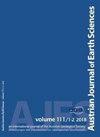下奥地利州喀斯特泉的统计分析
IF 1.1
4区 地球科学
Q4 GEOSCIENCES, MULTIDISCIPLINARY
引用次数: 0
摘要
岩溶泉在奥地利的供水中起着核心作用。本文旨在概述下奥地利岩溶泉,分析其空间分布、放电、电导率(EC)和温度的统计相关性。作为与下奥地利省政府合作项目的一部分,来自众多研究的旧数据已与地理信息系统数据库中自行生成的数据相结合。该数据库包含2056个岩溶泉的数据。有记录的岩溶泉大部分位于北钙质阿尔卑斯山脉,但在阿尔卑斯中部二叠纪、Waschberg带和波西米亚地块也有岩溶泉,其中一些对饮用水供应也具有区域重要性。化学分析表明,石灰岩、白云岩和混合泉水在下奥州分布广泛,出现频率相似。石膏泉,其特点是一个显著较高的总矿化,也具有区域重要性。统计分析表明,在流域平均海拔高度,泉水温度与年平均气温有较好的相关关系。温度随海拔升高而降低,对应于东阿尔卑斯地区的气温梯度(0.47°C/100 m)。此外,泉水的EC与流域平均海拔呈负相关,这可以解释为土壤覆盖减少,从而减少了水对CO 2的吸收,以及雨水的稀释。这导致碳酸盐溶解减少,这也反映在较少的hco3−含量上。经高程效应校正后,所研究的白云岩温泉的EC平均比石灰岩温泉高2.7%。haupt白云岩和weterstein白云岩的岩石类型也存在差异,后者的数值平均高出2.2%。这表明由于湿润白云岩的岩溶作用较少,泉水的停留时间较长。本文章由计算机程序翻译,如有差异,请以英文原文为准。
Statistical analysis of karst springs in Lower Austria
Abstract Karst springs play a central role in Austria’s water supply. This paper aims to provide an overview of the karst springs of Lower Austria, analysing statistical correlations of spatial distribution, discharge, electrical conductivity (EC), and temperature. As part of a project with the provincial government of Lower Austria, older data from numerous studies have been combined with the self-generated data in a GIS database. This database contains data on 2056 karst springs. Most of the recorded springs are located in the Northern Calcareous Alps, although karst springs also occur in the Central Alpine Permomesozoic, the Waschberg zone and the Bohemian Massif, some of which are also of regional importance for drinking water supply. Chemical analyses show that limestone, dolomite and mixed springs are widespread in Lower Austria and occur with similar frequency. Gypsum springs, which are characterised by a significantly higher total mineral-isation, are also of regional importance. The statistical analysis shows that spring water temperatures correlate well with the mean annual air temperature at the mean catchment elevation. The temperature decrease with increasing elevation corresponds to the air temperature gradient in the Eastern Alps (0.47 °C/100 m). In addition, the springs show a negative correlation of the EC with the mean catchment elevation, which can be explained by a decrease in soil cover and thus reduced CO 2 uptake of the water, as well as dilution by rainwater. This leads to less carbonate dissolution, which is also reflected in less HCO 3 − contents. Corrected for the elevation effect, the investigated dolomite springs, have on average a 2.7% higher EC than limestone springs. A difference was also found between the Hauptdolomit and the Wettersteindolomit rock types, which are widespread in Lower Austria, with the latter displaying higher values on average by 2.2%. This indicates longer residence times of the spring water due to less karstification of the Wettersteindolomit.
求助全文
通过发布文献求助,成功后即可免费获取论文全文。
去求助
来源期刊

Austrian Journal of Earth Sciences
GEOSCIENCES, MULTIDISCIPLINARY-
自引率
0.00%
发文量
0
期刊介绍:
AUSTRIAN JOURNAL OF EARTH SCIENCES is the official journal of the Austrian Geological, Mineralogical and Palaeontological Societies, hosted by a country that is famous for its spectacular mountains that are the birthplace for many geological and mineralogical concepts in modern Earth science.
AUSTRIAN JOURNAL OF EARTH SCIENCE focuses on all aspects relevant to the geosciences of the Alps, Bohemian Massif and surrounding areas. Contributions on other regions are welcome if they embed their findings into a conceptual framework that relates the contribution to Alpine-type orogens and Alpine regions in general, and are thus relevant to an international audience. Contributions are subject to peer review and editorial control according to SCI guidelines to ensure that the required standard of scientific excellence is maintained.
 求助内容:
求助内容: 应助结果提醒方式:
应助结果提醒方式:


